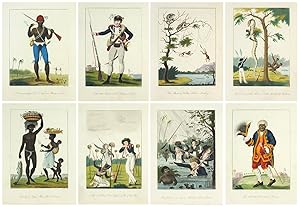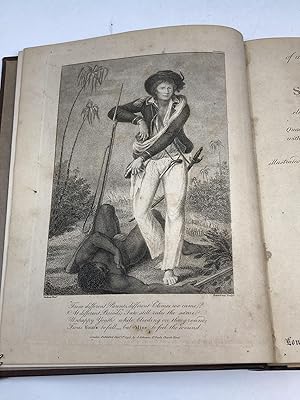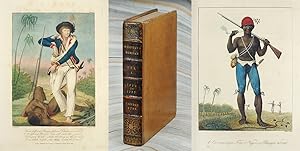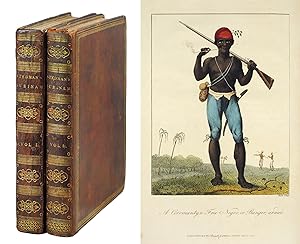Stedman Captain John Gabriel (6 results)
FeedbackSearch filters
Product Type
- All Product Types
- Books (6)
- Magazines & Periodicals (No further results match this refinement)
- Comics (No further results match this refinement)
- Sheet Music (No further results match this refinement)
- Art, Prints & Posters (No further results match this refinement)
- Photographs (No further results match this refinement)
- Maps (No further results match this refinement)
- Manuscripts & Paper Collectibles (No further results match this refinement)
Condition
- All Conditions
- New (No further results match this refinement)
- Used (6)
Binding
- All Bindings
- Hardcover (4)
- Softcover (No further results match this refinement)
Collectible Attributes
- First Edition (2)
- Signed (No further results match this refinement)
- Dust Jacket (No further results match this refinement)
- Seller-Supplied Images (6)
- Not Print on Demand (6)
Free Shipping
Seller Rating
-
Narrative of a Five Years' Expedition Against the Revolted Negroes of Surinam on the Wild Coast of South American from the Years 1772 to 1777 (2 Volumrs in Slipcase)
Published by Imprint Society, Barre, MA, 1971
ISBN 10: 0876360150 ISBN 13: 9780876360156
Seller: Dorley House Books, Inc., Hagerstown, MD, U.S.A.
First Edition
Hardcover. Condition: Near Fine. frontispiece, folding maps, plates (some folding) and tables. [223] (illustrator). 1st. 1st thus Limited edition of 1950 copies of which this is #743 and is signed by Rudolph van Lier who wrote the introduction and notes. in very good slipcase; navy c w/marbled boards paper labels. i-xviii, 1-220, (223)-480, 80 engravings from drawings made by the author. SIGNED By Editor.
-
Narrative of a Five Year's Expedition Against the Revolted Negroes of Surinam.
Seller: John Windle Antiquarian Bookseller, ABAA, San Francisco, CA, U.S.A.
London: J. Johnson, 1813. 4to, 3 uncoloured plates by Blake, from Vol II; Size 26.5 x 20. 5 cm. Rather browned and foxed in places, particularly to the edges. § Third edition. The plates are: "The Quato. Monkeys", "Limes, Capsicum.", "Flagellation of a Female.". Essick, William Blake's Commercial Book Illustrations, XXXIII p 71 - 75.
-
Narrative of a Five Year's Expedition Against the Revolted Negroes of Surinam.
Seller: John Windle Antiquarian Bookseller, ABAA, San Francisco, CA, U.S.A.
London: J. Johnson, 1813. 4to, 8 plates from the 1813 (third) edition. The plates are clean and in good condition hand-coloured with the standard palette, measuring 26.5 x 20.5 cm. § The plates are - "A Free Coromantyn Negro", "A Private Marine." , "The Mecoo and Kishee Monkeys", "The Skinning of the Aboma Snake", " Family of Negro Slaves.," The Skulls of Lieut. Leppar.", "March Thro' a Swamp or Marsh, in Terra-Firma", "The Celebrated Graman Quacy". Essick, William Blake's Commercial Book Illustrations, XXXIII p 71 - 75.
-
NARRATIVE OF A FIVE YEARS EXPEDITION AGAINST THE REVOLTED NEGROES OF SURINAM
Published by Johnston. Johnson & T. Payne, London, 1813
Seller: Aardvark Rare Books, ABAA, EUGENE, OR, U.S.A.
Leather-bound. Condition: Very Good. Second Edition. 2vol. 4to 4to. 2 folding maps 78 plates including 13 by Blake, from drawings made by the Author. Simply but nicly rebound in 1/4 leather over dark brown cloth. Second edition, corrected. List of subscribers. As is frequently seen, some offsetting to pages opposite plates. One of the most famous and fascinating military, travel, and humanistic books of all history. The account of the unsuccessful attempt to put down the revolted Negros of Dutch Surinam. Full title: Narrative of a five years' expedition against the revolted Negroes of Surinam in Guiana, on the wild coast of South America, from the year 1772 to 1777 : elucidating the history of that country, and describing its productions, viz. quadrupedes, birds, fishes [sic], reptiles, trees, shrubs, fruits and roots : with an account of the Indians of Guiana, and Negroes of Guinea. With its first-hand depictions of slavery and other aspects of colonization, this book became an important tool in the early abolitionist cause. A vivid portrayal of a battle for the village of Gado Saby can be seen in the frontispiece of Stedman's Narrative, which depicts Stedman standing over a dead slave in the foreground and a village burning in the distance. Stedman contrasts the beauty and sweetness of the colony with his first taste of the violence and cruelty endemic there. Stedman met Joanna, a mulatto slave, soon after arriving in Surinam (see portrait opposite p. 95) Stedman was captivated by Joanna's looks and charm, and they soon began a romance. Before long they had a son together, named Johnny. Throughout his Narrative, Stedman praises Joanna's character and sweet nature. He often describes instances of her loyalty and devotion to him through his absences and illnesses. Joanna died in 1782, after which their son migrated to Europe to live with Stedman. Stedman served in the Scots Brigade, a regiment of mercenary troops that had been established by the Netherlands to help protect its constitutional interests. In 1772, he volunteered to accompany the expedition sent by the States-General to subdue the insurgents in Dutch Guiana. However, the book takes a strong anti-slavery stance (as witnessed by the involvement of the progressive William Blake): Stedman describes the cruelties practiced on the slaves, and shows the moral deterioration of their masters. (from Auction Records Stedman served in the Scots Brigade, a regiment of mercenary troops that had been established by the Netherlands to help protect its constitutional interests. In 1772, he volunteered to accompany the expedition sent by the States-General to subdue the insurgents in Dutch Guiana. However, the book takes a strong anti-slavery stance (as witnessed by the involvement of the progressive William Blake): Stedman describes the cruelties practiced on the slaves, and shows the moral deterioration of their masters) (from Sotheby's auction records(L20409-57, 2020) One scholar notes: "the later editions in English are the prefered text for any scholar interested in the power of Stedeman's witness against slavery. " ".During the Dutch colonial period, Suriname was a lucrative source of sugar, its plantation economy driven by African slave labor and, after abolition of slavery in 1863, indentured servants from Asia.The Netherlands abolished slavery in Suriname in 1863, under a gradual process that required enslaved people to work on plantations for 10 transition years for minimal pay, which was considered as partial compensation for their masters." (Wikipedia) It will be noticed that a William Blake engraved thirteen plates, while three plates were engraved by Bartolozzi". "Many of the plates, it will be noticed, were engraved by [William] Blake, who had learnt his trade from Basire, to whom he was apprenticed for seven years from August 1772. As Keynes says in his bibliography From 1791 until 1800 Blake did much of his work as a journeyman engraver for the booksellers" (Abbey). Keynes eventually decided that Blake was responsibl.
-
Narrative of a Five Year's Expedition Against the Revolted Negroes of Surinam.
Seller: John Windle Antiquarian Bookseller, ABAA, San Francisco, CA, U.S.A.
First Edition
London: J. Johnson, 1796. Vol I only. 4to, xviii, 407 (i.e. 415), (7, index, plates, errata) pp., with 40 hand-coloured plates as called for including hand-coloured frontispiece and title page vignette. Very good in contemporary brown calf with gilt rules, decoration, and titling to spine with five raised bands. Internally good: some offsetting and very occasional foxing; front endpaper torn but expertly repaired. § First edition. Sixteen of the plates (and per a recent discovery the vignettes on the title-pages, one of which has the miniscule signature "Blake") were engraved by Blake after Stedman's drawings. This book had a substantial impact on Blake, who refers specifically to one of the illustrations that he engraved (that of a slave branded with his owner's initials, ironically those of Stedman himself) in his Visions of the Daughters of Albion: "Stampt with my signet are the swarthy children of the sun". As Forum noted in their catalogue 105 item 265: "Most impressive however, and very modern, are his vivid descriptions of the brutal treatment of the negroes, and his enlightened reflections upon the moral perversions of the slave-owners, leading him to pronounce the strongest possible indictment against slavery ever raised? His observations gave rise to a storm of protest in liberal Europe? his unexpurgated version was only recently published." Abbey, Travel, 719. Bentley 499A. Essick, William Blake's Commercial Book Illustrations, XXXIII. Kress Library 16679. Ray, Illustrator and the Book in England, 2. Volume 1 aquired from Chelsea Rare Books: Vol 2 was sadly stolen from their shop.
-
Narrative of a Five Year's Expedition Against the Revolted Negroes of Surinam.
Seller: John Windle Antiquarian Bookseller, ABAA, San Francisco, CA, U.S.A.
London: J, Johnson, 1806. 2 vols. 4to, xviii, 423, (4, index and plate list); iv, 419 ( 6, index and plate list) pp, with 40 hand-coloured plates in both vol I and vol II as called for plus hand-coloured title page to vol I and coloured vignette to both volumes. 16 of the plates and the two title page vignettes are by Blake. Contemporary diamond calf with gilt rules and decoration, including to spine, with general light wear, the front cover of vol I rehinged; internally good, some offsetting and spotting to reverse of a few plates, occasional mild foxing to margins, but generally a good clean copy. § Second edition, revised and enlarged, very scarce colored. Stedman's account of the slave rebellion in Dutch Guiana, 1772-1777, with 40 hand-colored plates, 16 by William Blake. A best-seller in its day and translated many times, Stedman's narrative was an important resource for the abolitionist movement across Europe, even though Stedman himself was not straightforwardly anti-slavery. Stedman based the text on personal diaries he kept on his travels (now held by the University of Minnesota), albeit with his numerous accounts of sexual liaisons with free and enslaved women reduced and romaticised. Essick writes that "Stedman's narrative of the brutalities of slavery very probably influenced Blake's own anti-slavery position"; Blake's graphic illustrations of abused slaves, infused with human dignity, undoubtedly influenced the reading public and advanced the abolitionist's cause. Essick, William Blake's Commercial Book Illustrations, XXXIII. Bentley, Blake Books, 499.







